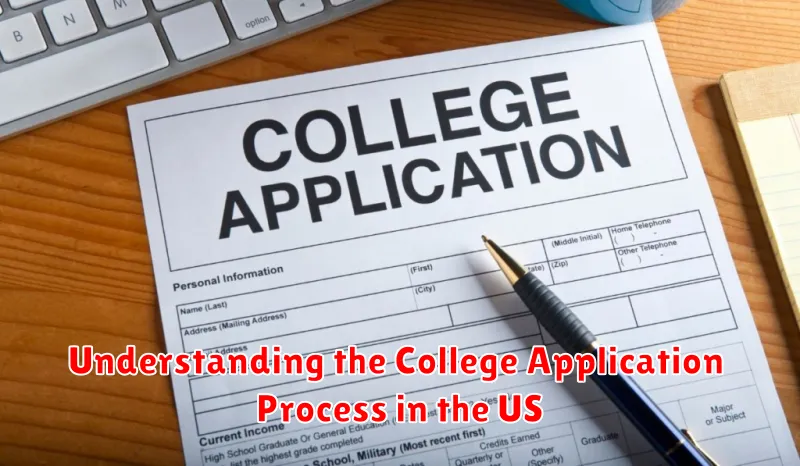Navigating the college application process in the US can feel overwhelming. This comprehensive guide aims to demystify the steps involved, providing prospective students with a clear roadmap from initial research to final decision. Understanding the key components, including standardized tests (SAT, ACT), GPA requirements, application essays, and financial aid, is crucial for a successful application. We will explore each element in detail, offering practical tips and resources to help you approach this process with confidence. Whether you are a high school freshman beginning your college search or a senior preparing to submit your applications, this guide offers valuable insights to make informed decisions every step of the way.
From selecting the right colleges to crafting compelling application essays, the college application process demands careful planning and execution. This guide will delve into the intricacies of each stage, offering practical advice on building a strong application. We’ll cover crucial aspects such as researching college rankings, understanding admission requirements, securing letters of recommendation, and navigating the Common Application. By the end of this guide, you will be equipped with the knowledge and tools necessary to present yourself effectively and maximize your chances of gaining admission to your dream college.
What Is the College Application Timeline?
The college application timeline is a crucial roadmap for students navigating the admissions process. It outlines the key deadlines and milestones to ensure a smooth and successful application experience.
While specific dates vary by institution, the general timeline spans from the spring/summer of junior year through the spring of senior year.
Key Milestones:
- Junior Year (Spring/Summer): Begin researching colleges, take standardized tests (SAT/ACT), and explore extracurricular activities.
- Senior Year (Summer/Fall): Request transcripts and letters of recommendation, finalize college list, and complete applications.
- Senior Year (Winter): Submit applications by deadlines, track application status, and potentially interview with colleges.
- Senior Year (Spring): Receive admissions decisions, compare financial aid packages, and make your final college choice.
Early Decision and Early Action deadlines typically fall in November, significantly earlier than regular decision deadlines.
Key Documents You Need to Prepare
Applying to US colleges requires gathering several essential documents. Being organized and starting early is crucial. This preparation allows you to focus on presenting your strongest application.
High School Transcript: This official record of your academic performance is a cornerstone of your application. It shows your course selections, grades, and GPA. Request your transcript from your high school guidance counselor well in advance of application deadlines.
Standardized Test Scores (SAT/ACT): While many colleges have adopted test-optional policies, submitting scores can still strengthen some applications. Check each college’s requirements and decide if submitting scores is the right choice for you.
Letters of Recommendation: These letters, typically from teachers or counselors, provide insights into your character, academic abilities, and extracurricular involvement. Ask potential recommenders early and provide them with ample time to write a thoughtful letter.
Personal Essay: This essay offers a unique opportunity to showcase your personality, experiences, and aspirations. Craft a compelling narrative that reflects your genuine self and addresses the essay prompt effectively.
How to Write a Compelling Personal Statement

Your personal statement is a crucial part of your college application. It’s your opportunity to showcase who you are beyond grades and test scores. It allows you to present a compelling narrative of your experiences, aspirations, and what makes you a unique individual.
Brainstorm and Reflect: Before writing, take time to reflect on your experiences. Consider significant events, challenges overcome, and pivotal moments that have shaped you. What are your passions, values, and goals? Identify a central theme or narrative thread that ties your experiences together.
Structure and Clarity: Organize your thoughts logically. A clear and concise structure is essential. Start with a captivating introduction that grabs the reader’s attention. Develop your narrative with specific examples and anecdotes that illustrate your qualities. Conclude with a thoughtful reflection on how your experiences have prepared you for college and beyond.
Authenticity and Voice: Be genuine and let your personality shine through. Write in your own voice and avoid clichés. The admissions committee wants to get to know the real you.
Revision and Proofreading: After writing, revise and proofread meticulously. Ensure your statement is free of grammatical errors and typos. Seek feedback from trusted teachers, counselors, or mentors.
Understanding Early Decision vs. Regular Decision

Navigating the college application process involves understanding the different application deadlines. Two common options are Early Decision (ED) and Regular Decision (RD). Choosing the right one can significantly impact your college application strategy.
Early Decision is a binding agreement. If accepted, you must attend that college. It demonstrates strong interest and often has higher acceptance rates, but limits your ability to compare financial aid packages from multiple schools. The deadline is typically in November.
Regular Decision is non-binding. You can apply to multiple colleges and compare financial aid offers before making a final decision. The deadline is usually in January or February.
Key Differences Summarized
| Feature | Early Decision | Regular Decision |
|---|---|---|
| Binding? | Yes | No |
| Application Deadline | Typically November | Typically January/February |
| Decision Notification | Typically December/January | Typically March/April |
Importance of SAT and ACT Scores
SAT and ACT scores play a significant role in the US college application process. These standardized tests are designed to assess a student’s readiness for college-level academics. Admissions committees use these scores to evaluate applicants’ abilities in key areas such as reading, writing, and math.
While some colleges have adopted test-optional policies, a strong SAT or ACT score can significantly strengthen an application, especially for competitive institutions. These scores can provide objective data to support a student’s academic record, particularly when applying to schools outside of one’s local area where grading standards may vary.
Furthermore, high scores can open doors to merit-based scholarships and specialized programs. Many colleges and universities use standardized test scores as a factor in awarding financial aid and determining eligibility for honors colleges or other selective programs.
Getting Recommendation Letters

Recommendation letters are a crucial part of your college application. They offer a third-party perspective on your abilities, character, and potential. These letters provide insights into your strengths and qualities that may not be apparent in other parts of your application.
Whom should you ask? Choose recommenders who know you well and can speak to your academic capabilities and personal qualities. Teachers, counselors, or other mentors who have directly observed your work and interactions are ideal choices.
When should you ask? Request letters well in advance of application deadlines. Giving your recommenders ample time allows them to craft thoughtful and detailed letters. Aim for at least a month or two before the deadline.
What information should you provide? Equip your recommenders with information to write a strong letter. This could include your transcript, resume, a list of activities, and a brief statement of your goals and why you are applying to specific colleges.
Following Up: After sending your request, politely follow up to confirm their willingness and remind them of deadlines. After they submit the letter, express your gratitude with a thank-you note.
Application Fees and Waivers
Applying to colleges often involves an application fee. This fee covers the administrative costs of processing your application. Fees typically range from $30 to $90 per application, although some institutions may charge more or less.
If you are facing financial hardship, you may be eligible for an application fee waiver. These waivers eliminate the cost of applying and are generally available to students who meet specific criteria, such as participation in federal assistance programs or demonstrated financial need. Contact the admissions office of each college you are interested in to learn about their specific fee waiver requirements and process. Often, you will need to complete a waiver request form and provide supporting documentation.
Some colleges automatically offer fee waivers based on information provided in your application, such as your participation in certain programs or your family’s income. Be sure to thoroughly review each college’s application procedures to understand their fee waiver policies.
Tips for International Applicants

Applying to US colleges as an international student requires additional steps. Start early, as the application process can be lengthy. Research visa requirements and begin the process well in advance.
English language proficiency is crucial. Most institutions require standardized test scores like TOEFL or IELTS. Ensure you meet the minimum score requirements for your chosen programs.
Transcripts and grading systems vary internationally. Have your academic credentials officially evaluated by a recognized credential evaluation service. This ensures US universities understand your academic background.
Financial planning is essential. Demonstrate you have sufficient funds to cover tuition, living expenses, and other related costs. Explore scholarship opportunities specifically for international students.
Understand the cultural differences and expectations of the US education system. Research the student support services available for international students at your prospective universities.

